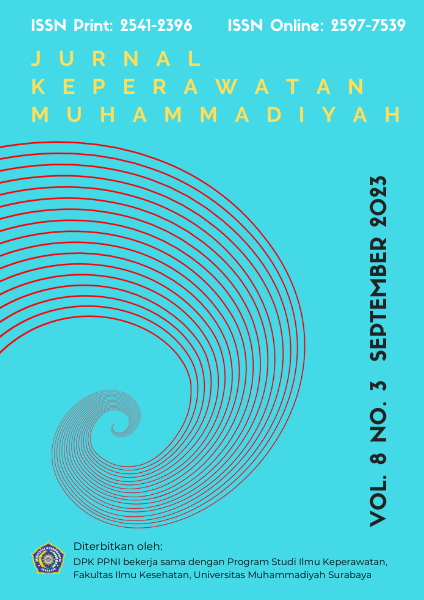Perbedaan Kadar Prokalsitonin Pada Anak Sepsis Dan Sepsis Berat Berusia 3-36 Bulan
DOI:
https://doi.org/10.30651/jkm.v8i3.19705Kata Kunci:
Sepsis, severe sepsis, procalcitoninAbstrak
Objective: Â Â Sepsis is one of the causes of high morbidity, mortality and length of hospitalization, especially infants. The incidence of severe sepsis in children is estimated at 40,000 cases per year, with 10-15% of progressing to septic shock. Â The clinical diagnosis of sepsis is difficult because of the nonspecific signs and symptoms, such as fever.
Methods:    Design research is pre experiment with case control descriptive analytic for  procalcitonin in severe sepsis and sepsis. There are 40 children aged 3-36 months with sepsis and severe sepsis. Data were analyzed statistically using normality test is then followed by different test independent test samples.Results:    The results showed a significant difference between the levels of procalcitonin in sepsis patients as compared to the levels of procalcitonin in patients with severe sepsis.
Conclusion: 1. The maximum procalcitonin at patients diagnosed with sepsis 290 ng / ml2.   The maximum procalcitonin at patients diagnosed with severe sepsis   443 ng / ml3.  there was significant difference between the levels of procalcitonin in sepsis patients as compared to the levels of procalcitonin in patients with severe sepsis with p-value = 0.000 (p<0.05)Referensi
Amanda P,Magdy W. (2007). Duration of fever and markers of serious bacterial infection in young febrile children. Pediatrics international. 49:31-35.
Carcillo JA, Fields AI. (2002). Clinical practice variables for hemodynamic support of pediatric and neonatal patients in septic shock. Crit Care Med.30:1365-78.
Dellinger P, Levy M, Carlet J, Bion J, Parker M, Jaeschke R, et al. (2008). Surviving sepsis campaign guidelines for management of severe sepsis and septic shock. Intensive care Med. 34:17-60.
Gardner SL. (2009). Sepsis in the Neonate. Crit Care Nurs Clin N Am. 21:121–141
Goldstein B, Giroir B, Randolph A. (2005). International pediatric sepsis consensus conference: definitions for sepsis and organ dysfunction in pediatrics. Ped Critical Care Medical.;6:2-8.
IDAI. (2014). Penanganan Demam Pada Anak. IDAI JATIM 10-14.
In Ho Park MD, Seung Hyun Lee MD, Seung TY MD. (2014). Serum procalcitonin as a diagnostic marker neonatal sepsis. Korean J paedtric;57(10):451-566.
Jiri Z, Martin V. (2015). Procalcitonin biomarker kinetics to predict multiorgan dysfunction syndrome in children with sepsis and systematic inflammatory response syndrome. Iran Journal Pediatri 25(1):e324.
Jose R, Fernanda de C, Rossano C, Sandra M, Cilmery S, Marcos A et al. (2007). Procalcitonin in children with sepsis and septic shock. Journal de Pediatria vol 83;4: 323-328.
Kibe S, Adams K and Gavin Barlow G. (2011). Diagnostic and prognostic biomarkers of sepsis in critical care. J Antimicrob Chemother. 66(2):ii33–ii40.
Lidia Decembrino, Mara De amici, Margherita Pozzi, Annalisa DE Silvestri, Mauro stronati (2015). Serum calprotectin : a potential biomarker for neonatal sepsis. Jounal of Hindawi Immunolog;. 147973.
Martin GS, Mannino DM, Eaton S, Moss M. (2003). The epidemiology of sepsis in the United States from 1979 through 2000. N Engl J Med; 348:1546–54.
Munford RS. (2012). Severe Sepsis and Septic Shock: Introduction. In: Fauci AS, Kasper DL, Longo DL, Braunwald E, Hauser SL, Lameson JL, et al, editors. Harrison’s Principles of Internal Medicine, 18th edition. New York: McGraw-Hill.
Nakamura Misa, Kono R, Nomura S, Utsunomiya H. (2013). Procalcitonin: Mysterious protein in sepsis. Journal of basic and clinical medicine. 7-11.
Paterson RL, Webster NR. (2000). Sepsis and the systemic inflammatory response syndrome. JR.Coll. Surg. Edinb; 45:178-82.
Reinhart K, Meisner M, Brunkhorst FM. (2006). Markers for Sepsis Diagnosis: What Is Useful. Crit Care Clin; 22:503-519.
Rivers E, Nguyen B, Havstad S, Ressler J, Muzzin A, Knoblich B, et al. (2001). Early goal-directed therapy in the treatment of severe sepsis and septic shock. N Engl J Med, 345:1368-77
Schuetz P, Christ-Crain M, Müller B. (2009). Procalcitonin and other biomarkers to improve assessment and antibiotic stewardship in infections. Swiss Med Wkly. 139(23–24):318–326.
Soedarmo, SSP., Garna,H., Hadinegoro, SRS., Safari, H.I., (2012). Sepsis dan Syok Septik dalam Buku Ajar Infeksi Pediatri Tropis. Edisi Kedua. Cetakan ke-3. Ikatan Dokter Anak Indonesia. Balai Penerbit IDAI Jakarta.
Soegeng S, Yulia. (2010). Tatalaksana Muktahir Kasus demam pada anak. Ikatan Dokter Anak Indonesia. Balai penerbit IDAI Jatim.1-12.
Silveira RC, Giacomini C, and Procianoy RS. (2010). Neonatal sepsis and septic shock: concepts update and review. Rev Bras Ter Intensiva. 22(3):280-290.Simon Liliana, Gauvin France, Amre DK, Louis PS. 2004 Serum Procalcitonin and C-reactive Protein Levels as Markers of Bacterial infection : A systematic review and meta-analysis. Clinical Inf disease ;39:206-17.
Sucilathangam, Amuthalavalli, Velvizhi, Ashhabegum M.A, Jeyamurugan T, Palaniappan. (2012). Early diagnostic markers for neonatal sepsis: comparing procalcitonin and c-reactive protein. Journal of clin and diagnostic research vol 6(4):627-631.
Terrin G, Passariello A, Manguso F, Sucilathangam, Amuthalavalli, Velvizhi, Ashhabegum M.A, Jeyamurugan T, Palaniappan. (2012). Early diagnostic markers for neonatal sepsis: comparing procalcitonin and c-reactive protein. journ of clin and diagnostic research vol 6(4):627-631.
Thibodeau G, Joyal J, and Lacroix J. (2014). Management of neonatal sepsis in term newborns. Prime Reports. 6(67):1-8.
Unduhan
Diterbitkan
Terbitan
Bagian
Lisensi
Hak Cipta (c) 2023 Maria Atik Wijayanti

Artikel ini berlisensiCreative Commons Attribution-ShareAlike 4.0 International License.
- Penulis tetap memegang hak atas karyanya dan memberikan hak publikasi pertama kepada jurnal ini yang secara simultan karya tersebut dilisensikan di bawah:Â Creative Commons Attribution-ShareAlike 4.0 International (CC BY-SA 4.0)













